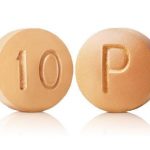
Contents
Side Effects of Norvasc (amlodipine besylate)
Norvasc (amlodipine) is a calcium channel blocker (CCB) used to treat and prevent angina resulting from coronary spasm as well as from exertion. Norvasc is also used to treat high blood pressure (hypertension).
Chest pain or heart pain (angina) occurs due to insufficient oxygen delivered to the heart muscles, resulting from coronary artery blockage or spasm, or due to exertion in patients with coronary artery narrowing (coronary artery disease or atherosclerosis).
Common side effects of Norvasc:
- headache
- swelling of the lower extremities
- dizziness
- flushing
- fatigue
- nausea
- palpitations
Serious side effects of Norvasc:
- increased frequency and severity of angina
- heart attacks
- congestive heart failure
Drug interactions of Norvasc with sildenafil and similar drugs used to treat erectile dysfunction may lead to excessive lowering of blood pressure with complications.
Use of Norvasc significantly increases blood levels of simvastatin.
The following, combined with Norvasc, results in excessive blood pressure reduction:
Generally, Norvasc is avoided in pregnancy, nursing mothers, and children although there are no adequate studies of Norvasc use during pregnancy. It is unknown if Norvasc is excreted in breast milk.
What are the side effects of Norvasc (amlodipine besylate)?
Side effects of amlodipine are generally mild and reversible. The two most common side effects are:
- headache
- edema (swelling) of the lower extremities
Other side effects include:
More serious side effects include:
- increase in the frequency and severity of angina
- heart attacks
- congestive heart failure
Increase in the frequency and severity of angina or heart attack due to amlodipine happens rarely in patients with severe coronary artery disease when first starting amlodipine, or at the time of an increase in dosage.
Excessive lowering of blood pressure during initiation of amlodipine treatment can occur, especially in patients already taking other medications that lower blood pressure.
In rare instances, congestive heart failure has been associated with amlodipine, particularly in patients already taking a beta blocker.
Norvasc (amlodipine besylate) side effects list for healthcare professionals
Clinical Trials Experience
- Because clinical trials are conducted under widely varying conditions, adverse reaction rates observed in the clinical trials of a drug cannot be directly compared to rates in the clinical trials of another drug and may not reflect the rates observed in practice.
- Norvasc has been evaluated for safety in more than 11,000 patients in U.S. and foreign clinical trials.
- In general, treatment with Norvasc was well-tolerated at doses up to 10 mg daily. Most adverse reactions reported during therapy with Norvasc were of mild or moderate severity.
- In controlled clinical trials directly comparing Norvasc (N=1730) at doses up to 10 mg to placebo (N=1250), discontinuation of Norvasc because of adverse reactions was required in only about 1.5% of patients and was not significantly different from placebo (about 1%).
- The most commonly reported side effects more frequent than placebo are:
| Amlodipine | Placebo N=520 |
|||
| 2.5 mg N=275 |
5 mg N=296 |
10 mg N=268 |
||
| Edema | 1.8 | 3.0 | 10.8 | 0.6 |
| Dizziness | 1.1 | 3.4 | 3.4 | 1.5 |
| Flushing | 0.7 | 1.4 | 2.6 | 0.0 |
| Palpitation | 0.7 | 1.4 | 4.5 | 0.6 |
Other adverse reactions that were not clearly dose related but were reported with an incidence greater than 1.0% in placebo-controlled clinical trials include:
| Norvasc (%) (N=1730) |
Placebo (%) (N=1250) |
|
| Fatigue | 4.5 | 2.8 |
| Nausea | 2.9 | 1.9 |
| Abdominal Pain | 1.6 | 0.3 |
| Somnolence | 1.4 | 0.6 |
For several adverse experiences that appear to be drug and dose related, there was a greater incidence in women than men associated with amlodipine treatment:
| Norvasc | Placebo | |||
| Male=% (N=1218) |
Female=% (N=512) |
Male=% (N=914) |
Female=% (N=336) |
|
| Edema | 5.6 | 14.6 | 1.4 | 5.1 |
| Flushing | 1.5 | 4.5 | 0.3 | 0.9 |
| Palpitations | 1.4 | 3.3 | 0.9 | 0.9 |
| Somnolence | 1.3 | 1.6 | 0.8 | 0.3 |
The following events occurred in 0.1% of patients in controlled clinical trials or under conditions of open trials or marketing experience:
Cardiovascular: arrhythmia (including ventricular tachycardia and atrial fibrillation), bradycardia, chest pain, peripheral ischemia, syncope, tachycardia, vasculitis.
Central and Peripheral Nervous System: hypoesthesia, neuropathy peripheral, paresthesia, tremor, vertigo.
General: allergic reaction, asthenia, back pain, hot flushes, malaise, pain, rigors, weight gain, weight decrease.
Musculoskeletal System: arthralgia, arthrosis, muscle cramps, myalgia.
Psychiatric: sexual dysfunction (male and female), insomnia, nervousness, depression, abnormal dreams, anxiety, depersonalization.
Respiratory System: dyspnea, epistaxis.
Skin and Appendages: angioedema, erythema multiforme, pruritus, rash, rash erythematous, rash maculopapular.
Urinary System: micturition frequency, micturition disorder, nocturia.
Autonomic Nervous System: dry mouth, sweating increased.
Hemopoietic: leukopenia, purpura, thrombocytopenia.
Norvasc therapy has not been associated with clinically significant changes in routine laboratory tests. No clinically relevant changes were noted in:
- serum potassium
- serum glucose
- total triglycerides
- total cholesterol
- HDL cholesterol
- uric acid
- blood urea nitrogen
- creatinine
In the CAMELOT and PREVENT studies, the adverse event profile was similar to that reported previously (see above), with the most common adverse event being peripheral edema.
Postmarketing Experience
Because these reactions are reported voluntarily from a population of uncertain size, it is not always possible to reliably estimate their frequency or establish a causal relationship to drug exposure.
The following postmarketing events have been reported infrequently where a causal relationship is uncertain: gynecomastia, jaundice, and hepatic enzyme elevations (mostly consistent with cholestasis or hepatitis). Postmarketing reporting has also revealed a possible association between extrapyramidal disorder and amlodipine.
Norvasc has been used safely in patients with chronic obstructive pulmonary disease, well-compensated congestive heart failure, coronary artery disease, peripheral vascular disease, diabetes mellitus, and abnormal lipid profiles.
1 These events occurred in less than 1% in placebo-controlled trials but had an incidence between 1% and 2% in all multiple dose studies.
What drugs interact with Norvasc (amlodipine besylate)?
Impact Of Other Drugs On Amlodipine
CYP3A Inhibitors
Co-administration with CYP3A inhibitors (moderate and strong) results in increased systemic exposure to amlodipine and may require dose reduction. Monitor for symptoms of hypotension and edema when amlodipine is co-administered with CYP3A inhibitors to determine the need for dose adjustment.
CYP3A Inducers
No information is available on the quantitative effects of CYP3A inducers on amlodipine. Blood pressure should be closely monitored when amlodipine is co-administered with CYP3A inducers.
Sildenafil
Monitor for hypotension when sildenafil is co-administered with amlodipine.
Impact Of Amlodipine On Other Drugs
Simvastatin
Co-administration of simvastatin with amlodipine increases the systemic exposure of simvastatin. Limit the dose of simvastatin in patients on amlodipine to 20 mg daily.
Immunosuppressants
Amlodipine may increase the systemic exposure of cyclosporine or tacrolimus when co-administered. Frequent monitoring of trough blood levels of cyclosporine and tacrolimus is recommended and adjust the dose when appropriate.
Summary
Norvasc (amlodipine) is a calcium channel blocker (CCB) used to treat and prevent angina resulting from coronary spasm as well as from exertion. Norvasc is also used to treat high blood pressure (hypertension). Common side effects of Norvasc include headache, swelling of the lower extremities, dizziness, flushing, fatigue, nausea, and palpitations. Generally, Norvasc is avoided in pregnancy, nursing mothers, and children although there are no adequate studies of Norvasc use during pregnancy. It is unknown if Norvasc is excreted in breast milk.


